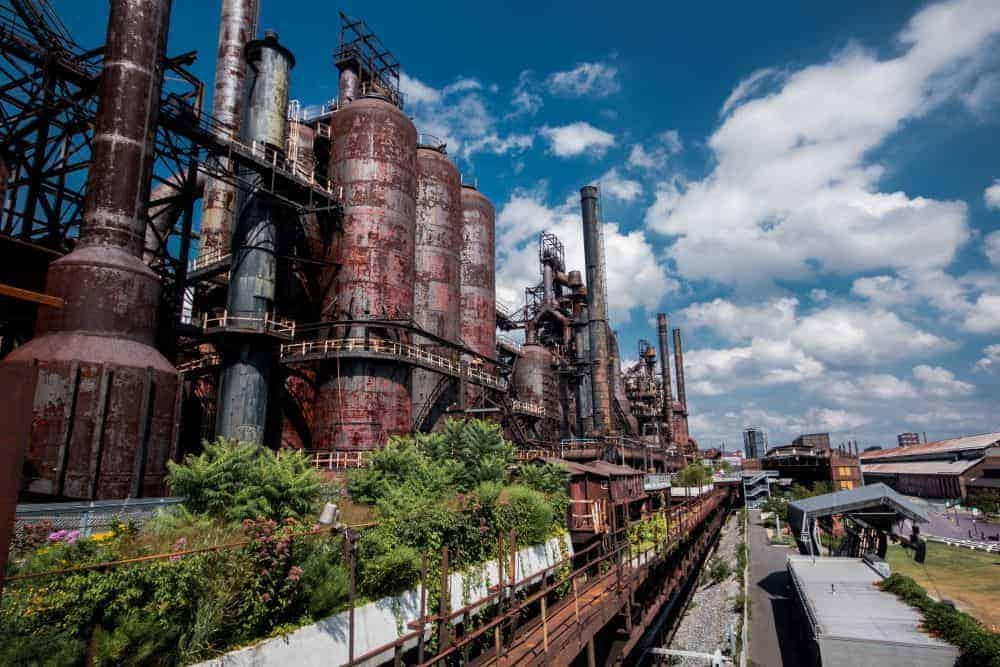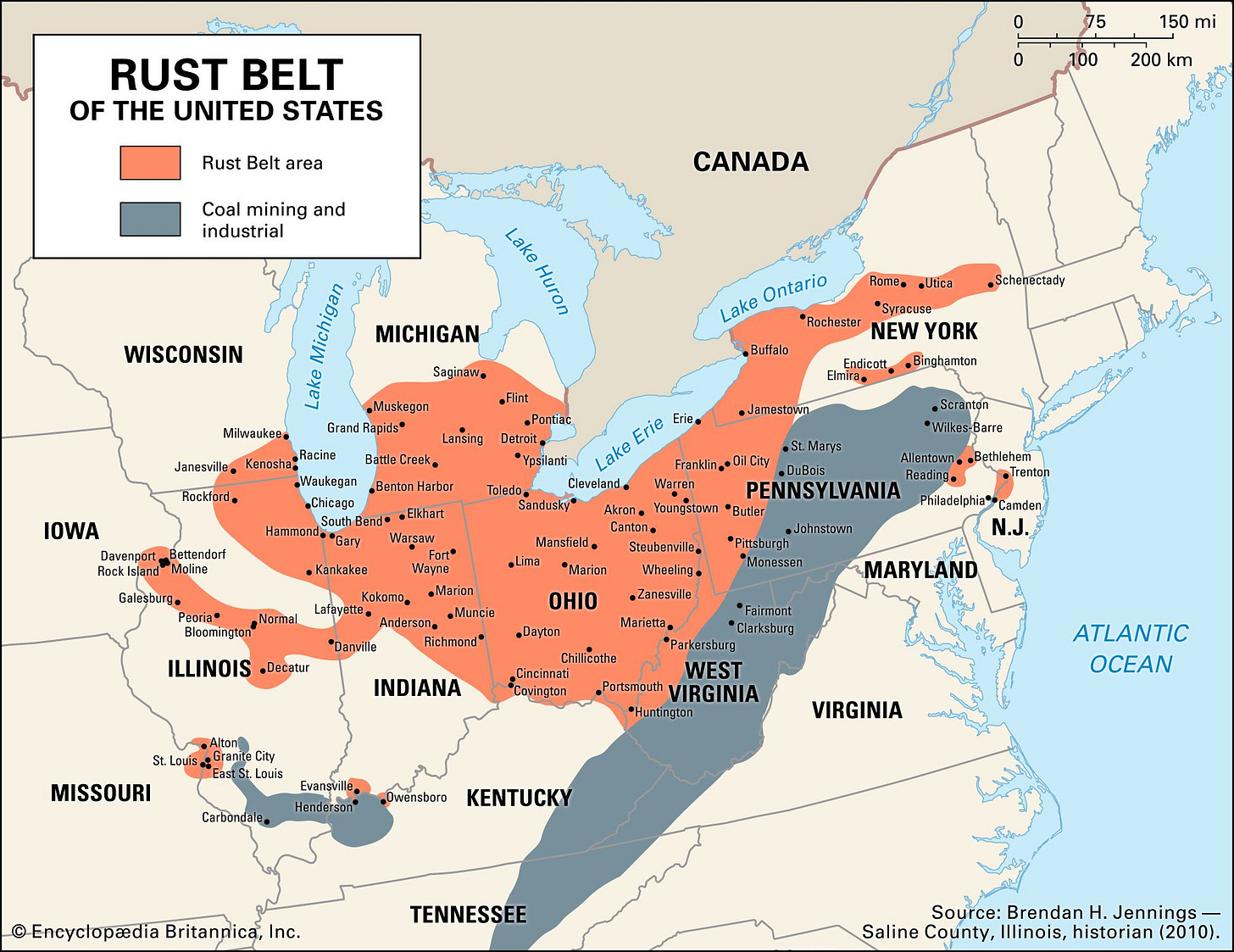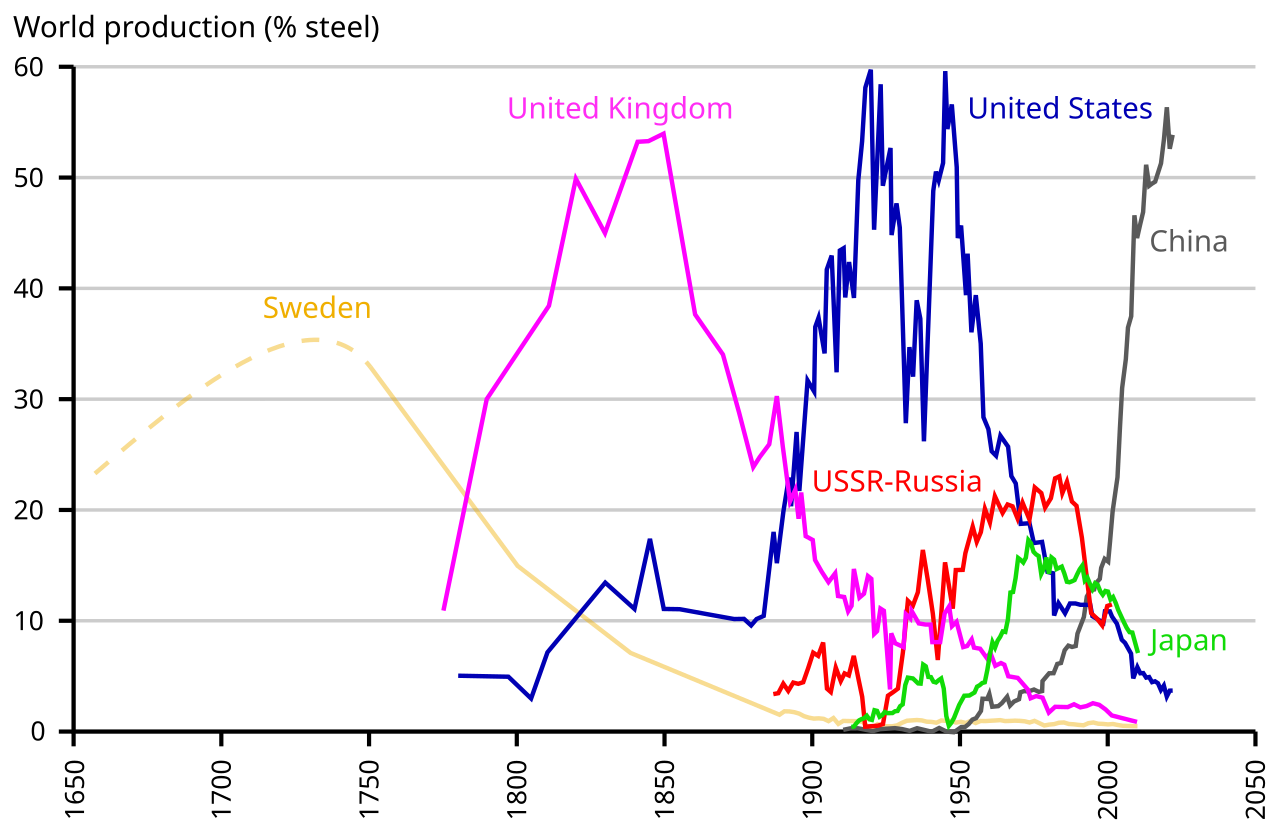Made In America
Why the Rust Belt rusted.
If you find this article interesting, click the like button for me! I would greatly appreciate it :)
If you had to guess, what do the Empire State Building, Golden Gate Bridge, Hoover Dam, and Alcatraz Island have in common? You could say something like iconic US landmarks, or they were finished in the 1930s, but I’m looking for something specific. These iconic structures weren’t just American-made, but all had steel coming from a plant in a small Pennsylvania town.
The Bethlehem/Allentown area, north of Philadelphia, was home to the Bethlehem Steel Corporation until 2003. Once one of the largest steel and ship producers in the entire world, it was crucial in the construction of a laundry list of important American buildings, not to mention the lifeblood of the US military in the world wars. Pennsylvania was the steel capital of the world for a while, with the Carnegie Steel revolution in Pittsburgh, and hosted tremendous production for decades. This state falls in the Rust Belt, a derogatory term for the region in the Midwest/mid-Atlantic region known for its run-down factories and depressed economic environment.
The 1960s were the last decade the United States was the top producer of steel in the world. Candidates for the last iconic American-made landmark are the Space Needle (Seattle), Gateway Arch (St. Louis), World Trade Center (NYC), or even the US interstate system, all completed in the 60s/70s. Japan/Russia rose to prominence as the top steel producer in the 80s and 90s, only to be dethroned by China in the 2000s onward. What and where do you think the most iconic structures are today?
The Rusting
Cleveland, Detroit, Buffalo, Allentown, and many more were all cities with booming industry. Now they are mostly shells of their former glory, often with only dilapidated buildings remaining. Some have rallied behind Universities or other industries, while others are still struggling to this day. It did not happen overnight, but gradually from the 70s on. Songs about the woes of the region were written by major artists like Bruce Springsteen with “Youngstown” in 1995 or Billy Joel with “Allentown” in 1982. While US manufacturing was mostly gutted by the 2000s, the hardship is still felt in popular culture, with the viral song “Rich Men North Of Richmond” by Oliver Anthony in 2023.
Globalization and the rise of Asian manufacturing in the 2000s were the nail in the coffin for US manufacturing, but it was not the root cause, as the trend began long before. NAFTA, and before that, GATT, lowered tariffs and trade barriers around the world, resulting in easier trade and lower cost of imports.
Wages and the middle class grew fast in the post-WWII era. It was not long before lower wages in other countries began to look attractive. Combine this with countries more willing to burn coal, and there was a recipe for arbitrage. Despite deregulation efforts in the 80s, wages, energy, and other regulations added costs to US manufacturing.
Finally, with the Bretton Woods agreement for free trade in US dollars after WWII, the world's reserve currency was solidified. Demand for dollars rose as trade and lending necessitated dollars. After the abandonment of the gold convertibility in 1971, US dollars were now the de facto money for the entire world. Bretton Woods created demand for dollars, leaving a lower value of foreign currency, making foreign exports relatively more attractive. Excessive liabilities were adding up as US fiscal deficits outpaced gold reserves, resulting in the suspension of gold convertibility as countries like France realized the arbitrage. The US had a price cap on gold and was selling it to maintain the price cap, but was quickly running out. The US froze convertibility and defaulted on its obligations; however, no one was willing to stand up to the military might of the nation in response. Without the constraint of gold after 1971, the US could fund further deficits and import freely without the demand to exchange gold, which would rise in price due to the deficits. As you would expect, the gold price shot up without the need to suppress the price.
This is the biggest factor as to why we have structural trade deficits. Every country needs and wants dollars to trade and to buy US assets with. Historically, countries attempting to move away from the US dollar have been hit with heavy force, like sanctions or war. Since the US can print money without the gold constraint, the trade deficit is structural. Unless the US becomes fiscally responsible, which would lead to economic calamity, the structural deficit remains. This is why both administrations’ strategies of tariffs or subsidies will not solve the trade deficit, as the structural driver remains.
This is why the rust belt rusted, and why Trump is not serious about re-shoring or reducing the trade deficit. Unless the US reduces the fiscal deficit and subsequently freezes global trade, nothing will change. This would halt the recycling of dollars into US assets, resulting in a collapse in US stock/bond prices, as foreign nations have no money to reinvest.
Populism
The consequence of the rust belt and the disenfranchisement of the working class through lower real wages and fewer job prospects is populism. Trump is the perfect example of a populist leader, leveraging the angst of the people he promises he is there for. What will define Trump populism is whether he decides to truly fight for the people that voted for him or degenerates into something else with the power, the most infamous examples being the 1930s authoritarians.
Populism can place blame for societal ills on various sources, including race, elitism, foreign countries, corporations, or intellectuals. You can clearly see Trump’s plays on many of these factors with the wall/immigrant issues, draining the “swamp”, China trade war, and attacks on universities. Democrats are not free from rising populism, as social welfare for marginalized racial or economic groups and attacks on wealthy elites or corporations are effective political topics.
In general, the Rust Belt regions have polarized most heavily, and it is hard not to blame them. Middle-class families in the Rust Belt have become impoverished and lost their jobs to foreigners. It is not hard to see how a figure like Trump, who promises to be “for them,” gets rid of the politicians who got them there, and keeps out the foreigners stealing their jobs, is appealing, even if it may not be the whole picture. Urbanites in Rust Belt cities may also be discontent, and regardless of race and political ideology, they are voting more with their discontent on either political side, even if neither party actually wants to solve the issues.
Implications
Both Biden and Trump spoke of re-shoring American industry, facing China’s growing economic power, and addressing wealth inequality. Structural trade deficits for the abovementioned reasons are why neither party will be effective in bringing back manufacturing. Higher labor and energy regulations are further barriers. Even if they can convince some companies to return, it will not be in the way we expect.
Dark factories in China are already operational, allowing for drastically reduced labor and energy costs. With these prices even higher in the US, factories will adopt automation over bringing jobs back. Amazon will soon have more robots than humans and is rapidly advancing its AI and automation capabilities.
Re-shoring America is an empty promise, one that will be automated even if it does happen. Even if the US wants to get rid of minimum wage, safety regulations, and environmental regulations, you still contend with the structural trade deficit from the reserve currency status. Ending this would cause global trade disruption and a halting of US dollars invested in US assets like bonds and stocks, crashing the values of these as well as pushing the global economy into recession. No politician would willingly do this or realistically be able to.
Analyzing the Rust Belt region is the easiest way to understand the rising populism and the election of Trump in the US. Unfortunately, it is unlikely that the rising populist leaders on either side will have the will or ability to change the root cause of the American rust. I cannot predict the future, but the issue will continue to progress in predictable ways. Placing blame on race, elites, foreign nations, corporations, or intellectuals will be the norm instead of the US taking responsibility for its policies. Politicians will use this blame to get elected on both sides of the aisle without solving the root cause of the Rust Belt woes. Individuals, all the way up to the government, would be wise to take responsibility for their lives and problems instead of placing blame on others, even if there is some blame to be shared.
Until next week,
-Grayson
Socials
Twitter/X - @graysonhoteling
Archive - The Gray Area
Notes - The Gray Area
Promotions
Sign up for TradingView





If we get closer to conflict with China they may decide to stop selling steel to us (and lots of other stuff).(?)